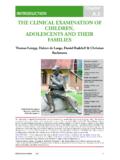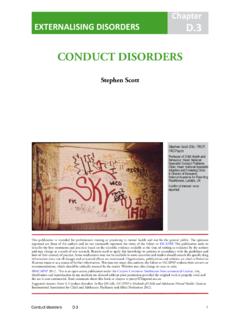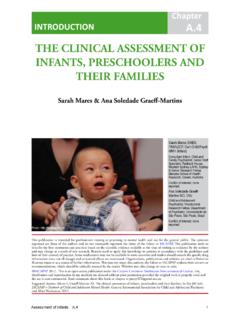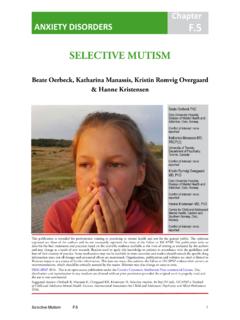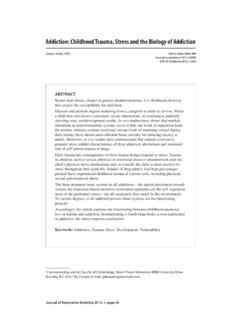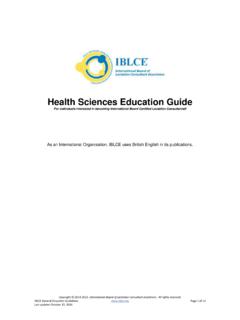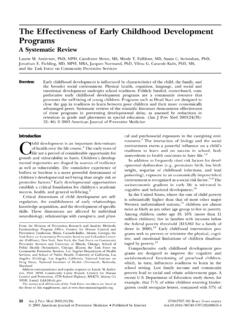Transcription of INFANCY, CHILDHOOD AND ADOLESCENCE - iacapap.org
1 IACAPAP Textbook of Child and Adolescent Mental Health Chapter INTRODUCTION NORMAL DEVELOPMENT. INFANCY, CHILDHOOD AND. ADOLESCENCE . Nancy G Guerra, Ariel A Williamson & Beatriz Lucas-Molina Watoto Wema boys enjoying a game in Kenya Nancy G Guerra EdD. (Photo: Dennis Machio-Michezo Afrika). Associate Dean for Research, College of Arts and Sciences;. University of Delaware, Newark, DE, USA. Conflict of interest: none declared Ariel A Williamson MA. University of Delaware, Newark, DE, USA. Conflict of interest: none declared Beatriz Lucas-Molina PhD. La Rioja University, Spain Conflict of interest: none declared This publication is intended for professionals training or practicing in mental health and not for the general public. The opinions expressed are those of the authors and do not necessarily represent the views of the Editor or IACAPAP. This publication seeks to describe the best treatments and practices based on the scientific evidence available at the time of writing as evaluated by the authors and may change as a result of new research.
2 Readers need to apply this knowledge to patients in accordance with the guidelines and laws of their country of practice. Some medications may not be available in some countries and readers should consult the specific drug information since not all dosages and unwanted effects are mentioned. Organizations, publications and websites are cited or linked to illustrate issues or as a source of further information. This does not mean that authors, the Editor or IACAPAP endorse their content or recommendations, which should be critically assessed by the reader. Websites may also change or cease to exist. IACAPAP 2012. This is an open-access publication under the Creative Commons Attribution Non-commercial License. Use, distribution and reproduction in any medium are allowed without prior permission provided the original work is properly cited and the use is non-commercial. Send comments about this book or chapter to Suggested citation: Guerra NG, Williamson AA, Lucas-Molina B.
3 Normal development: Infancy, CHILDHOOD , and ADOLESCENCE . In Rey JM (ed), IACAPAP e-Textbook of Child and Adolescent Mental Health. Geneva: International Association for Child and Adolescent Psychiatry and Allied Professions 2012. Normal development 1. IACAPAP Textbook of Child and Adolescent Mental Health A. 15-year-old girl starts throwing nightly tantrums if she doesn't get desert after dinner. Her mother is justifiably concerned and seeks the help of a mental health professional. Yet when her three-year-old son does the same thing, she sends him to his room, convinced this is a passing phase he will outgrow in due time. The mother probably is right the same behavior has very different meanings for toddlers and teenagers. Without a working knowledge of normal development the same mother might send the three-year-old to a therapist or the teenager to her room. For parents, this knowledge comes from multiple sources including experience, friends, cultural traditions, magazines and books, support networks, and more recently electronic sources such as websites and chat rooms.
4 Parents also rely on guidance counselors, social workers, therapists, and physicians to help them understand typical and atypical behaviors. Yet health professionals often are more versed in the language of abnormality and psychopathology than in the language of normal growth and development. For example, the Diagnostic and Statistical Manual for Mental Disorders (DSM-IV-TR) and the International Statistical Classification of Diseases and Related Health Problems (ICD), provide clinicians with a compendium of criteria and categories for aberrant psychological development. However, these systems provide little information about normal development, which is not simply the absence or opposite of psychopathology. The purpose of this chapter is to give a brief overview of normal child development, defined as average or on-time growth based on the attainment of specific physical, cognitive, linguistic, social-emotional, and behavioral milestones across specific stages.
5 A focus on normal development suggests what is likely based on population averages, with clear historical, cultural, and international variations to be expected. A foundational understanding of average development can be useful to practitioners in many ways, from assisting clinicians in history taking or planning diagnostic work at intake to augmenting case conceptualization and the selection of developmentally-appropriate treatments (Holmbeck et al, 2010). This chapter begins with a review of key developmental principles or themes, including nature versus nurture, developmental timing and plasticity, critical and sensitive periods, and the role of culture and context. Following this brief introductory section, age-specific milestones in cognitive, linguistic, social- emotional, and behavioral development from infancy through ADOLESCENCE are reviewed. Although it is also important to understand normative milestones in the area of physical development, this typically is covered in medical and health publications and is beyond the scope of this chapter.
6 UNDERSTANDING NORMAL DEVELOPMENT. Several recurring developmental principles or themes are important to keep in mind when defining normal development and identifying growth processes and milestones. Nature versus nurture: the origins of development There has been a long history of debate about the influence of nature versus nurture on development, often referred to as the nature-nurture debate. Are we born a certain way or does our behavior depend on how we are raised? A focus on nature highlights the role of genes and biology in predetermining developmental Normal development 2. IACAPAP Textbook of Child and Adolescent Mental Health outcomes from conception onward. In contrast, a focus on nurture emphasizes the role of life experiences across different contexts including the family, school, peer group, community, and culture. Recent advances in behavior genetics have provided compelling evidence for the relative contributions of both nature and nurture.
7 In light of these scientific advances, few current theories of development embody an either/or position in this debate, but emphasize the interplay of both over time (Berk, 2006). Stated simply, a key issue is not whether development is due to nature or nurture, but how much and how each contributes to outcomes across multiple characteristics and domains. Rather than consider nature versus nurture, it is more accurate to consider both nature and nurture and how they interact (Plomin et al, 1995). The empirical evidence on the relative contribution of nature and nurture comes largely from family, twin, and adoption studies, as well as from more recent DNA analyses. Much of the research on the genetic roots of behavior has focused on disorders or problem behaviors, including mental retardation, schizophrenia, autism, alcoholism, aggression, and criminality. A strong relation between biology and development has been found for chromosomal and single-gene disorders such as Trisomy 21 (Down's Syndrome).
8 The genetic contribution for disorders involving multiple genes is more complex to determine with estimates varying widely across studies. For example, heritability estimates for alcoholism have been found ranging from to , depending on symptoms (McGue, 1994). In any case, the influence of environmental factors such as parenting styles, socioeconomic status, and neighborhood characteristics on mental illness, behavioral disorders, and other individual differences looms large (Meier et al, 2008; Turkheimer et al, 2003; Tuvblad et al, 2006). What do we know about the role of nature and nurture in children's normal development? Much of this work has focused on two areas: temperament and intelligence. Studies of infants and young children have examined temperamental characteristics such as reactivity, mood, shyness, sociability, emotionality, attention/. persistence, and adaptability. Because temperament is defined as stable and early appearing individual differences in behavioral tendencies, it is presumed to have strong biological roots.
9 Clearly identifiable and enduring patterns of behavior such as shyness have been observed in very young infants, suggesting children are born with these tendencies. Twin studies generally confirm this genetic contribution, with heritability estimates ranging from to (Saudino, 2005). Intelligence also has a high heritability factor, typically estimated to be about (Plomin et al, 1995); however, this may vary according to environmental differences like socioeconomic status (Turkheimer et al, 2003). But findings for both temperament and intelligence also mean that much of what differentiates individuals is not accounted for by a child's biological birth certificate. Some of these environmental influences vary between contexts. For instance, communities vary in terms of resources and families differ in terms of typical parenting practices. However, it is also important to remember that environmental influences within a given setting may be non-shared.
10 For example, parents may treat their children differently within the same family this is called the non-shared environment.. As mental health professionals consider the extent of their child clients'. normal or atypical development, it is important to recognize this complex interplay of nature and nurture and how this contributes to the clients' clinical presentations. Normal development 3. IACAPAP Textbook of Child and Adolescent Mental Health Additionally, educating youths' primary caregivers about the biological and environmental influences on development may dispel the misconception that children are products of either nature or nurture in isolation. A boy who is just like his father may have been born with some genetic similarities, but he also is equally likely to be modeling his father's behavior based on what he sees at home and elsewhere. Developmental timing and plasticity A second overarching theme within the developmental literature is the sequencing and variation within normative development.

